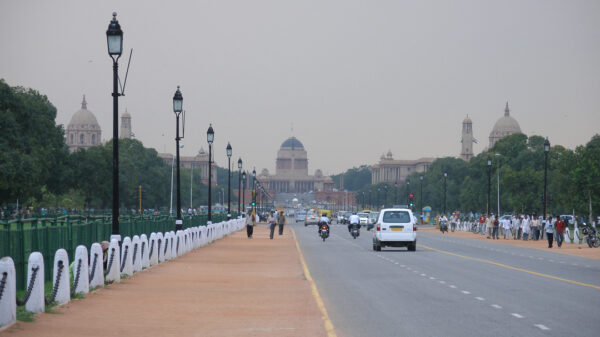Staff writer Aryan Pandla reviews Narendra Modi’s time as Prime Minister of India.
In the midst of a transformative shift in India’s political landscape back in 2014, the rise of Prime Minister Narendra Modi to power brought with it a surge of both anticipation and transformation. As the Modi-led NDA government completes almost a decade in office, let’s embark on a comprehensive analysis of this period, taking into account the nation’s economic growth, policy decisions, social dynamics, and the impact of global events.
The Economic Roller Coaster
The Modi era has been punctuated by a roller coaster of economic growth. India soared to become the world’s fifth-largest economy, surpassing the UK. However, this trajectory was marred by inconsistencies, most notably the COVID-induced contraction during the financial year 2020–21. The economy’s roller-coaster journey mirrored the fluctuating GDP growth rates. A crucial component of Modi’s legacy was the emphasis on economic growth and development, encapsulated in the “Make in India” campaign and the implementation of the Goods and Services Tax (GST).
Investment has been a focal point for the Modi government, as evidenced by various initiatives to attract Foreign Direct Investment (FDI). The “ease of doing business,” liberalization of FDI policies and legislative reforms aimed at creating an investment-friendly environment have yielded positive outcomes. Nevertheless, economic growth and job creation remain complex challenges. The growth rate was commendable, yet the creation of meaningful employment opportunities lagged behind, causing some to question the extent to which economic growth truly translated into societal welfare.
Symbolism and Statecraft: A Diplomatic Dance
Modi’s foreign policy marked a noteworthy departure from precedent, as it aimed to position India as a global player. This shift in strategy was strikingly exemplified by the resounding success of the recent G20 Summit held in the nation’s capital, New Delhi. This milestone event yielded an unprecedented unanimous declaration that revolved around the overarching theme of “One Earth, One Family, One Future.” Additionally, the “Neighbourhood First” approach sought to strengthen regional ties, while the “Act East” policy aimed at fostering broader Asian collaborations. Further, the “Make in India” initiative beckoned foreign investments, propelling India into the global economic arena. However, the geopolitical dynamics remained intricate.
Contentious relations with Pakistan and China underscored the complexities of maintaining harmonious international partnerships in a rapidly evolving global landscape. Although India has become a global strategic partner of the US, she has maintained amicable ties with Russia, her long-standing ally. This signifies the resurgence of non-alignment principles in the innovative guise of fostering multiple coalitions. India today finds herself in a unique position, and if she plays this great game right, the resurgence of the liberal international order on equitable principles is inevitable.
Interplay of Youth, Urbanization, and Technology
Modi’s ascent coincided with the confluence of three significant currents in Indian society. India’s demographic landscape was transformed by a burgeoning youth bulge, poised to yield the largest working-age population in the coming decades. The 2019 election marked a pivotal moment as the “youth vote” played a transformative role, drawn by the promises of economic growth and development. This youthful surge, accompanied by a tide of aspirations, holds the potential to redefine the contours of Indian politics for years to come.
Simultaneously, the urban landscape underwent a metamorphosis, with a substantial proportion of the nation’s GDP becoming anchored within cities. This urban surge gave rise to an expanding middle class characterised by heightened macroeconomic awareness. As voters began to distinguish between local and national elections, they started to realise that effective urban policy necessitated comprehensive approaches. This heightened urban consciousness paved the way for a novel perspective on governance and accountability.
In tandem with these shifts, a technological explosion reshaped India’s communication landscape. The proliferation of television and the internet, catalysed by the advent of social media, fundamentally redefined political outreach. The “Digital India” campaign harnessed these technological winds to bridge developmental gaps and usher in a governance paradigm that is both interconnected and efficient. Initiatives such as Aadhaar, the United Payments Interface (UPI), Direct Benefit Transfer (DBT), and the Jan Dhan Yojana sought to expand financial inclusion. Yet, these strides were not without their share of apprehensions. Privacy concerns and debates over data security cast shadows over the transformative potential of these technological innovations.
Challenges to Democracy and Cultural Diversity
The contours of Modi’s leadership were distinctly marked by policies and actions that bore implications for the delicate balance between cultural diversity and social harmony in India. The ethos of inclusivity, which the Indian Constitution cherishes, appeared at odds with certain instances that unfolded. Issues like the beef ban, cow vigilantism, mob lynching and controversies surrounding religious conversions and “love jihad” sparked concerns about religious intolerance and the polarizing undercurrents that accompanied such measures. The recent explosion in communal riots, with a specific focus on the targeting of the Muslim minority, is unprecedented, giving substance to the aforementioned claims. Critics lamented that these events strained the social fabric, potentially marginalising Muslim minority communities and promoting an atmosphere of discord.
A recent debacle of the present dispensation is the mishandling and delayed action on the Manipur crisis, which shows signs of majoritarian tendencies ushering in this new era of divisive politics. Further, a study by Lokniti-CSDS shows that 80% of journalists believe the media covers the Modi-led government too favourably; which highlights the debilitating state of freedom of speech and expression in India, further worsened by the monopolisation of a few media conglomerates. Moreover, the government introduced a Bill in the Rajya Sabha (Upper House of Parliament) on 10 August 2023, that seeks to replace the Chief Justice of India with a Cabinet Minister nominated by the Prime Minister in the committee for the selection of the Chief Election Commissioner and Election Commissioners. If this bill is passed, this will mark the end of true electoral democracy in India, making the Election Commission subservient to the whims of Parliament.
Domestic Realities: A Complex Story
Infrastructure development, a priority for the Modi government, particularly in highways, railways, and airports, has shown growth but faces challenges like pending ambitious projects. Healthcare and education spending, despite the COVID-19 crisis and policy reforms, remained relatively unchanged, signalling gaps. The 2016 demonetisation aimed to reduce cash usage and raise the tax-to-GDP ratio, with fluctuating outcomes. India’s efforts for self-reliance through initiatives like Make in India contrast with stagnant global merchandise exports, highlighting the struggle to balance domestic and international priorities.
Narendra Modi’s leadership, spanning 2014 to 2023, embodies a period of dynamic change and challenges. Analysing his governance reveals a tapestry woven with achievements and debacles. The debate over whether Modi fits the “messiah” mould sparks diverse discussions. Beyond rhetoric and biases, comprehensive analysis becomes crucial to fathoming the impact on India’s trajectory. This means examining the socio-economic, cultural, and political imprints the man has made. Such scrutiny rises above simplistic narratives, encouraging both supporters and critics to engage constructively.
As the curtains draw on Modi’s tenure, a complex picture emerges. The journey is punctuated with successes and setbacks as India navigates global shifts and domestic trials. The era reflects India’s pursuit of growth, empowerment, and global standing, interwoven with policy difficulties. Moving forward, lessons from this decade serve as stepping stones toward a future where transformation is an eternal promise. Amidst complexities, Modi’s leadership etches an enduring chapter in India’s evolving narrative.


















